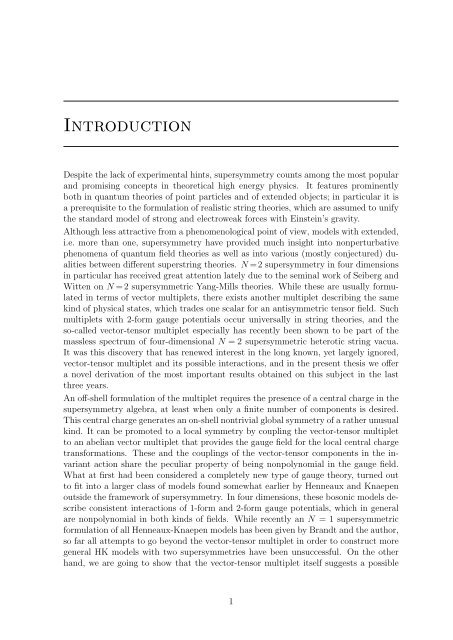N=2 Supersymmetric Gauge Theories with Nonpolynomial Interactions
N=2 Supersymmetric Gauge Theories with Nonpolynomial Interactions
N=2 Supersymmetric Gauge Theories with Nonpolynomial Interactions
You also want an ePaper? Increase the reach of your titles
YUMPU automatically turns print PDFs into web optimized ePapers that Google loves.
Introduction<br />
Despite the lack of experimental hints, supersymmetry counts among the most popular<br />
and promising concepts in theoretical high energy physics. It features prominently<br />
both in quantum theories of point particles and of extended objects; in particular it is<br />
a prerequisite to the formulation of realistic string theories, which are assumed to unify<br />
the standard model of strong and electroweak forces <strong>with</strong> Einstein’s gravity.<br />
Although less attractive from a phenomenological point of view, models <strong>with</strong> extended,<br />
i.e. more than one, supersymmetry have provided much insight into nonperturbative<br />
phenomena of quantum field theories as well as into various (mostly conjectured) dualities<br />
between different superstring theories. N =2 supersymmetry in four dimensions<br />
in particular has received great attention lately due to the seminal work of Seiberg and<br />
Witten on N = 2 supersymmetric Yang-Mills theories. While these are usually formulated<br />
in terms of vector multiplets, there exists another multiplet describing the same<br />
kind of physical states, which trades one scalar for an antisymmetric tensor field. Such<br />
multiplets <strong>with</strong> 2-form gauge potentials occur universally in string theories, and the<br />
so-called vector-tensor multiplet especially has recently been shown to be part of the<br />
massless spectrum of four-dimensional N = 2 supersymmetric heterotic string vacua.<br />
It was this discovery that has renewed interest in the long known, yet largely ignored,<br />
vector-tensor multiplet and its possible interactions, and in the present thesis we offer<br />
a novel derivation of the most important results obtained on this subject in the last<br />
three years.<br />
An off-shell formulation of the multiplet requires the presence of a central charge in the<br />
supersymmetry algebra, at least when only a finite number of components is desired.<br />
This central charge generates an on-shell nontrivial global symmetry of a rather unusual<br />
kind. It can be promoted to a local symmetry by coupling the vector-tensor multiplet<br />
to an abelian vector multiplet that provides the gauge field for the local central charge<br />
transformations. These and the couplings of the vector-tensor components in the invariant<br />
action share the peculiar property of being nonpolynomial in the gauge field.<br />
What at first had been considered a completely new type of gauge theory, turned out<br />
to fit into a larger class of models found somewhat earlier by Henneaux and Knaepen<br />
outside the framework of supersymmetry. In four dimensions, these bosonic models describe<br />
consistent interactions of 1-form and 2-form gauge potentials, which in general<br />
are nonpolynomial in both kinds of fields. While recently an N = 1 supersymmetric<br />
formulation of all Henneaux-Knaepen models has been given by Brandt and the author,<br />
so far all attempts to go beyond the vector-tensor multiplet in order to construct more<br />
general HK models <strong>with</strong> two supersymmetries have been unsuccessful. On the other<br />
hand, we are going to show that the vector-tensor multiplet itself suggests a possible<br />
1

















